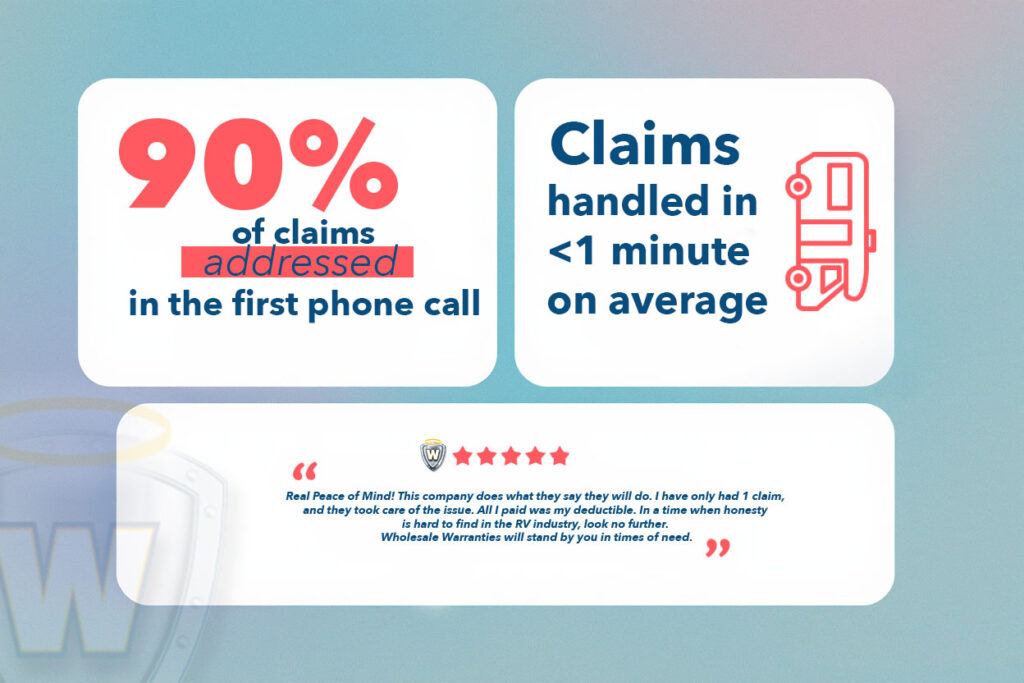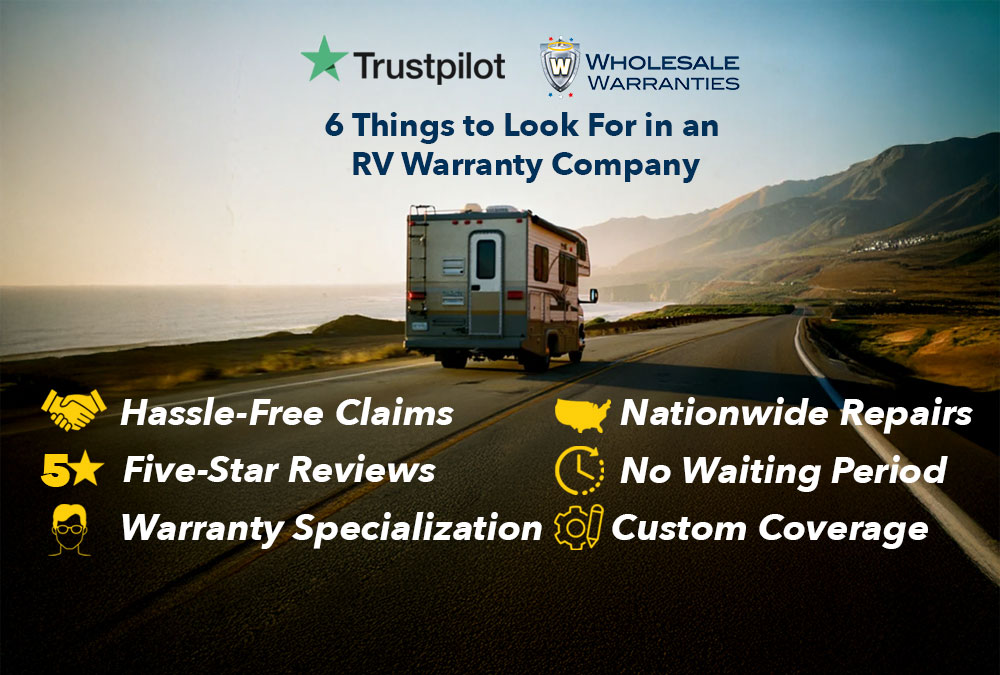
Living the RV lifestyle can be an incredibly rewarding experience. However, everyone hits roadblocks in their journey, including the occasional breakdown and repair headaches.
One way that RVers mitigate repair costs is with an extended RV warranty, or extended service contract. When it comes to repairs, understanding the RV warranty claims process is essential for ensuring maximum coverage. Knowing how to use your warranty will save you money and stress. In this blog, you will learn how to file claims, avoid common mistakes, and choose a trustworthy provider.
1. Understanding Your RV Warranty
The key to maximizing coverage is understanding what an RV warranty is and how it works. Contracts contain dense language and several sections, so be sure to read everything. If you come across confusing language, clarify the meaning with the provider.
1.1 What is an RV extended Warranty?
An RV extended warranty, also known as an extended service contract, is a policy designed to cover the costs associated with unexpected mechanical and electrical breakdowns. Essentially, an extended warranty extends the service of the original manufacturer warranty. Extended warranty terms depend on the provider, but they typically last between three and seven years.
The extent of RV warranty coverage depends on both the provider and policy type. With more comprehensive policies, coverage typically extends to the powertrain components, major appliances, and HVAC. Components not covered, called exclusions, are typically aesthetic components and wear-and-tear items. Regular maintenance is not covered under warranty.
1.2 Types of Extended Warranty Providers
When it comes to warranty providers, you have some options. Dealers and extended warranty companies sell policies on behalf of an insurance-backed administrator. Before choosing a type of provider, there are a few key points to consider.
Dealers will typically offer an extended service policy for purchase along with the purchase of a new RV. Although this is the convenient option, it may not be the best or most affordable option. Additionally, they generally provide little room for customization. Keep in mind that dealers specialize in selling RVs—not RV warranties.
Third-party brokers, or extended warranty companies, specialize in extended warranties. They typically provide a broader range of policy options from multiple warranty administrators. Plus, they offer plans for used RVs, so people can secure protection and add resale value for their well-loved rig. Some providers, such as Wholesale Warranties, even house a claims support team to serve as an advocate on behalf of the client.
2. Preparing for an RV Warranty Claim Before You Need One
To help ensure the claims process is as quick and smooth as possible, be prepared for a claim before you need to make one. Keep detailed records, be familiar with your coverage, and establish rapport with a trusted mechanic.
2.1 Keep Detailed Records
Keep all relevant documentation organized and up to date. This includes service history, warranty documents, and maintenance records. Be able to provide any of this information upon request.
2.2 Know What’s Covered
Have a solid understanding of your policy. Know what is covered. To properly read your warranty policy, read through it carefully. Then, go over each section again, taking notes if needed and researching terms. Consider making a copy in order to highlight key sections. A warranty specialist will be able to help clarify any confusion.
Understanding your policy is essential, as mistakes can lead to denied claims. The most common misunderstandings involve the extent of coverage. If a policyholder thinks a component is covered and actually is not, then they will likely be disappointed after trying to file a claim.
3. How to File an RV Warranty Claim
Knowing how to file an RV warranty claim is essential in order to make the most of your policy. This is something you will need to do should your RV suffer an unexpected breakdown or failure.
3.1 Step-by-Step Guide to Filing a Claim
Step 1: Review Your Policy
Refamiliarize yourself with the details of your warranty policy. Locate the administrator’s information and keep your documents on hand.
Step 2: Find a Repair Facility
Locate a licensed repair facility, preferably a trusted provider with a history of warranty work. Depending on your coverage, you may also have access to mobile mechanic services.
Step 3: Receive a Diagnosis
Have the mechanics thoroughly inspect and diagnose the vehicle. Upon diagnosis, have a repair shop representative provide the warranty administrator with a diagnostic report.
Step 4: Obtain Pre-Authorization
This is the most important step in the claims process. One of the most common mistakes that leads to claim denials is neglecting to receive pre-authorization before starting repairs. You may be denied even if you provide the invoice for the repair work. Depending on how lenient they are, the warranty company may still provide reimbursement; however, they are under no obligation to and typically will not.
Step 5: Begin Repairs
After obtaining pre-authorization, the mechanic is free to begin repair work. Depending on the severity of the issue or issues, repairs can take a couple of hours to several days to complete. This can be difficult when getting repairs on the road, so you may want to consider opting for trip interruption. This add-on can cover things like rental vehicles, lodging, and even meals. This is a great option for frequent road-trippers and full-timers. Ask your warranty specialist about trip interruption coverage when discussing policy options.
Step 6: Let Your Warranty Pay the Bill
3.2 Tips to Speed Up the Process
Repair times largely depend upon the mechanic and how responsive the warranty administrator is. Some ways to expedite the process from your end are being proactive and communicating clearly with both the provider and repair shop. If your warranty provider has their own claims assistance department, they will ensure the process moves along smoothly.
4. Avoiding Common Mistakes
Understanding your extended warranty is essential for avoiding common mistakes when filing a claim. Here are two important things to avoid so that you can enjoy full coverage.
4.1 Don’t Skip Maintenance
Neglecting routine care can end up voiding your coverage. Stay on top of regular maintenance and upkeep to save yourself a headache in the long run.
4.2 Avoid Unauthorized Repairs
Do not move forward with repair work before receiving prior authorization from the warranty administrator. Claims may be denied due to premature action. After receiving a diagnosis, call the administrator for approval.
5. Understanding How Warranty Providers Help Protect RV Owners
Not only does a warranty protect you from RV repair costs, but it can also protect you from overpaying on said repairs. Warranty providers hold mechanics accountable and prevent them from engaging in unfair practices.
5.1 Shielding You from Inflated Repair Costs
Owning an RV means committing to routine maintenance and occasional repairs, which is why it’s important to establish a relationship with a trusted repair shop. A reputable mechanic will be openly communicative, honest, and fair.
Finding a shop that meets these criteria is easier in one location, but it can be much harder to do so on the road when you’re in need of urgent repairs. It’s the unfortunate truth that some unfamiliar shops may take advantage of unassuming RV owners, which is where warranties become especially important.
Warranty companies have access to repair pricing and average times, so when your mechanic calls them with a diagnosis, the warranty company will ensure the pricing is accurate and fair. Warranties protect RV owners from inflated repair costs!
5.2 Authorized Repair Networks
To vet a mechanic, be sure to read detailed customer testimonials. Look for things like good communication, fairness, honesty, and punctuality. Make sure you find an authorized facility with the proper licensure. You can use this RV repair shop locator tool to find verified locations across the US that accept warranty work.
If you have a warranty, it’s important to only work with approved mechanics who accept warranty work. Wholesale Warranties offers nationwide coverage, meaning you have access to all licensed repair facilities in the US and Canada.
5.3 Oversight and Quality Control
When it comes to RV repairs, warranty companies provide additional oversight and quality control. Between dealers and warranty brokers, warranty companies provide varying degrees of oversight and accountability.
Some companies take a more hands-off approach by choosing not to require RV inspections or assist with the claims process. In this case, it becomes the customer’s burden to negotiate with the policy administrator. By contrast, Wholesale Warranties houses its own claims assistance department, acting as a mediator on behalf of the customer.
Customer advocacy is often the key to ensuring a claim is approved. At larger companies, this is typically a black-and-white matter. At Wholesale Warranties, however, our claims department receives diagnostic information from the customer or mechanic. Then, we speak with the administrator to ensure anything covered by the policy is actually covered. If the administrator disagrees, we may even cover the claim ourselves. Work with companies who prioritize customer experience and satisfaction.
6. What to Do if a Claim is Denied
RV warranty claim denials do occur for various reasons. In order to be prepared for this possibility, we can offer some advice for handling a claim denial.
6.1 Understanding the Denial
Being familiar with common reasons for claim denials will help you better understand a denial. If further clarification is needed, then content the warranty provider.
6.2 Common Claim Denials
Here are three examples of the most common reasons for warranty claim denial:
- Coverage Exclusion
- Insurance Item
- No Pre-authorization
A less common reason for claim denial is if you void your RV warranty by breaking compliance with the policy. Although this is generally difficult to do, you risk losing coverage if you make unapproved mechanical or electrical upgrades or neglect maintenance.
6.3 Appealing the Denial
Understandably, you may want to request clarification or documentation regarding the denial. To do so, contact the warranty company’s claims mediator. If that is not an option, contact the administrator directly. Be sure to have your policy and vehicle information on hand.
Even after clarification, sometimes customers are still dissatisfied with the claim decision. Fortunately, policyholders can choose to dispute a decision. Disputing a claim decision is much easier with dedicated claims staff available to help advocate for you. Involving a third party increases the odds of a successful appeal.
7. Choosing the Right RV Warranty Provider
There are a number of factors that go into determining the best RV warranty for you. First, you need to choose the right provider.
7.1 What to Look for in a Warranty Company

When researching warranty companies, keep these three R’s in mind:
- Reputation
- Responsiveness
- Reviews
Warranty policies can look very similar on paper, which is why the provider is the key factor. Read through verified reviews and claims testimonials. Choose a reputable provider that prioritizes communication and customer experience. Look for coverage add-ons and perks as well, such as mobile mechanic services, membership opportunities and discounts, and so on. For maximum peace of mind, consider a broker with their own in-house claims department, as they will help get claims approved on your behalf.
7.2 Questions to Ask Before Signing
Before signing an extended service contract, be sure to review the following with the warranty specialist:
- Coverage Limits
- Exclusions
- Claim Process Details
Once you thoroughly research the provider and understand the policy, you can feel confident about whether the provider will address claims fairly and punctually. Being informed about your RV warranty and choosing the right provider will guarantee stress-free RV warranty claims. Before you file a claim, be proactive and prepared for the possibility. Remember: the right warranty provider acts as a partner, not just a policy.
Frequently Asked Questions
How do I make a claim under warranty?
First, receive a diagnosis from a licensed repair facility. After reviewing your warranty policy, call the warranty administrator and provide the diagnostic report in order to obtain prior authorization to begin repairs. Receiving authorization before repairs is essential for ensuring coverage. Be sure to keep your warranty documents on hand.
How do RV warranties work?
RV warranties prevent out-of-pocket repair expenses. In the event of an appliance failure or mechanical breakdown, the policyholder will file a claim with the warranty administrator. The warranty will cover the cost of repairs for all covered components.
What is not covered by RV warranty?
Coverage varies depending on the policy and vehicle model, but there are always coverage exclusions. Exclusions are typically cosmetic components, routine maintenance, and items that would be covered by your regular insurance.
What will void my RV warranty?
Incorrectly filed claims, neglected maintenance, and unauthorized upgrades can void warranty coverage. To prevent this, stay on top of vehicle upkeep and maintain compliance with the terms of your policy. Ask the warranty provider before making any mechanical upgrades to your RV, and always obtain pre-authorization before starting warranty repair work.




